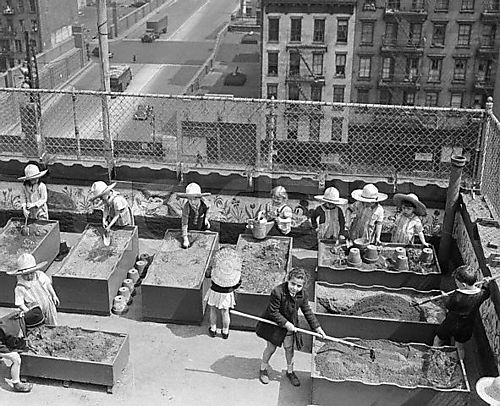'Victory Gardens' were also called war gardens or food gardens for defense. They were vegetable, fruit and herb gardens at private residential blocks and in public parks in the United States, United Kingdom, Canada, Australia and Germany during the First and Second World War. There were rations, especially canned food, needed for the troops. Railroads, trains, freight and roads were crowded by the military. Therefore, the governments were promoting growing and eating local fruits. Also to produce enough food.
There were rations, especially canned food, needed for the troops. Railroads, trains, freight and roads were crowded by the military. Therefore, the governments were promoting growing and eating local fruits. Also to produce enough food.
It's always been there. In times of war. Men went fighting. Some farmers remained on their land for food production. Women and children had to help massive to supplement the manpower that went falling in action..
In 1942 the British government proposed the plan "Victory Gardens". Each undeveloped piece of land is claimed and turned into vegetable garden. Women and girls were encouraged to do their part. A "Country Girl" had to be older than 18 years, and worked 48 hours per week for a minimum wage of about two pounds.
In the UK, 31,000 schoolchildren were housed in 650 camps to help harvesting. There were help-vacations to participate voluntarily in such a camp. A total of 350,000 volunteers responded.
The gardens were also considered by the government as a moral boost for the citizens so they could contribute to the fight. And received back a payment in kind. It was also a way to keep food prices low for the military. The money was needed for the war industry.
(Ladies) magazines and ministries gave instructions, tips, and courses on gardening and preserving.
"Our food is fighting," is on a US poster.
Also raising chickens was promoted. Some sports fields were not mowed, but grazed by sheep.
People without land made small Victory Gardens in flower boxes on window sills.
Many schools started Victory Gardens and used their products for their school lunches.
There were even planted gardens on the roofs of apartment buildings. Most Americans eat (then) local products, (self) grown in their own environment. Neighbors joined forces, formed cooperatives and spoke together on what crops they would grow, all in the name of patriotism.
In 1944 Victory Gardens were responsible for the production of 41% of all vegetables grown in the United States. The yield is estimated at 9-10000000 tons, about the same as all the commercial production of fresh vegetables.
There were 18 million victory gardens in the United States: 12 million in cities and six million on farms. There were e.g. more than 800 gardens in Golden Gate Park.
With the end of the war many people stopped with their garden. In the spring of 1946 there was much less sowed and planted. But agriculture was not yet turned on full blast, so then there were still food shortages.
Currently there is a growth in 'new' initiatives. Think of (Urban) Roof Gardening, Guerilla Gardening, Windows farming, school gardens, generation gardens ...
And often you can hear the question: is all this feasible and realistic, all those great new ideas of idealistic dreamers?
If the need is greatest ... So very new, it is actually not. It already happened by previous generations.
Perhaps the revival of these alternatives is a sign that we are back in a crisis. A war with nature, our environment, our health, our voracious economy ... Maybe we are preparing ourselves for the destruction of our modern society.
